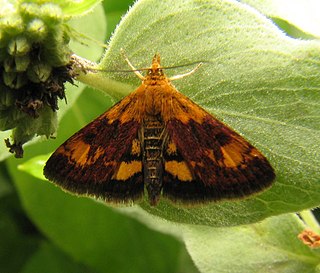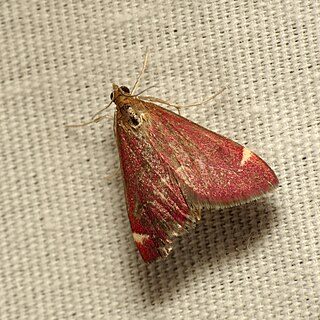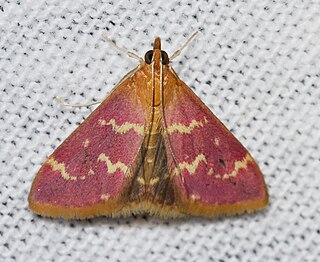
Pyrausta is a specious genus of moths of the family Crambidae. The genus was erected by Franz von Paula Schrank in 1802.

Pyrausta orphisalis, the orange mint moth or orange-spotted pyrausta, is a species of moth of the Crambidae family. It was described by Francis Walker in 1859. It is found in North America from Newfoundland west to British Columbia, south to Florida and New Mexico.

Pyrausta phoenicealis, the perilla leaf moth, is a moth of the family Crambidae described by Jacob Hübner in 1818. It is found worldwide, including the Americas, Africa, Australia and Asia.
Pyrausta demantrialis is a moth in the Crambidae family. It was described by Herbert Druce in 1895. It is found in the United States, where it has been recorded from Arizona, Florida, Indiana, Michigan, New Mexico, North Carolina, Pennsylvania, Texas and West Virginia. It has also been recorded from Mexico (Guerrero), Ecuador and Venezuela.

Pyrausta grotei is a moth in the Crambidae family. It was described by Eugene G. Munroe in 1976. It is found in North America, where it has been recorded from Washington, Oregon, Montana, California, Utah, Colorado, Wyoming, Nevada, Arizona and Texas.
Pyrausta ilithucialis is a moth in the family Crambidae. It was described by Francis Walker in 1859. It is found in Colombia.

Pyrausta inornatalis, the inornate pyrausta moth, is a moth in the family Crambidae. It was described by Charles H. Fernald in 1885. It is found in United States, where it has been recorded from Arizona, California, Florida, Kansas, Louisiana, Missouri, Oklahoma, Tennessee and Texas. It is also found in Mexico.
Pyrausta lethalis, the lethal pyrausta moth, is a moth in the Crambidae family. It was described by Augustus Radcliffe Grote in 1881. It is found in North America, where it has been recorded from California to southern Nevada, southern Arizona and Texas.
Pyrausta nexalis, the fulvous-edged pyrausta moth, is a moth in the Crambidae family. It was described by George Duryea Hulst in 1886. It is found in North America, where it has been recorded from Washington, Montana, Arizona, California, New Mexico, Oklahoma, Texas and Utah.
Pyrausta rhipheusalis is a moth in the family Crambidae. It was described by Francis Walker in 1859. It is found on Borneo.
Pyrausta roseivestalis is a moth in the Crambidae family. It was described by Eugene G. Munroe in 1976. It is found in North America, where it has been recorded from California and southern Arizona.
Pyrausta sartoralis is a moth in the Crambidae family. It was described by William Barnes and James Halliday McDunnough in 1914. It is found in North America, where it has been recorded from California and Arizona.

Pyrausta signatalis, the raspberry pyrausta moth, is a moth in the family Crambidae. It was described by Francis Walker in 1866. It is found in North America, where it has been recorded from British Columbia to Ontario, south to North Carolina, South Carolina, Texas and Arizona. The habitat consists of aspen parkland and grasslands.
Pyrausta subsequalis is a moth in the family Crambidae. It was described by Achille Guenée in 1854. It is found in North America, where it has been recorded from southern Alberta and southern British Columbia south to Arizona and New Mexico. The habitat consists of dry prairie areas.
Pyrausta theialis is a moth in the family Crambidae. It was described by Francis Walker in 1859. It is found on Borneo.

Pyrausta tyralis, the coffee-loving pyrausta moth, is a moth in the Crambidae family. It was described by Achille Guenée in 1854. It is found in the United States, where it has been recorded from New York to Illinois and from Florida to Arizona. It is also found from Mexico to Venezuela, as well as on the West Indies.
Pyrausta unifascialis, the one-banded pyrausta, is a moth in the Crambidae family. It was described by Packard in 1873. It is found in North America, where it has been recorded from Quebec west to British Columbia, south to Arizona and California. The habitat consists of forest openings, clearings and fields.
Pyrausta volupialis, the volupial pyrausta moth, is a moth in the Crambidae family. It was described by Augustus Radcliffe Grote in 1877. It is found in North America, where it has been recorded from Oklahoma, Utah, Texas, Colorado, New Mexico, Arizona and California to Chiapas, Mexico.
Diacme mopsalis, the mopsalis diacme moth, is a moth in the family Crambidae. It was described by Francis Walker in 1859. It is found in South America, Central America, the Antilles and the southern United States, where it has been recorded from Arizona, Florida, Oklahoma and Texas.











